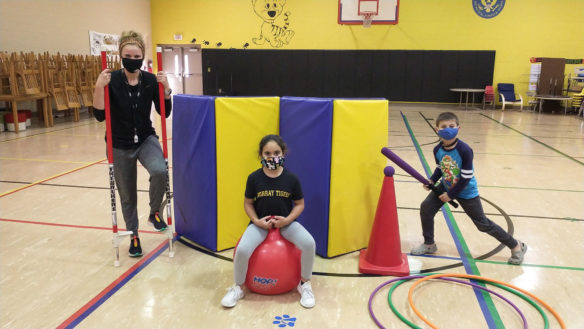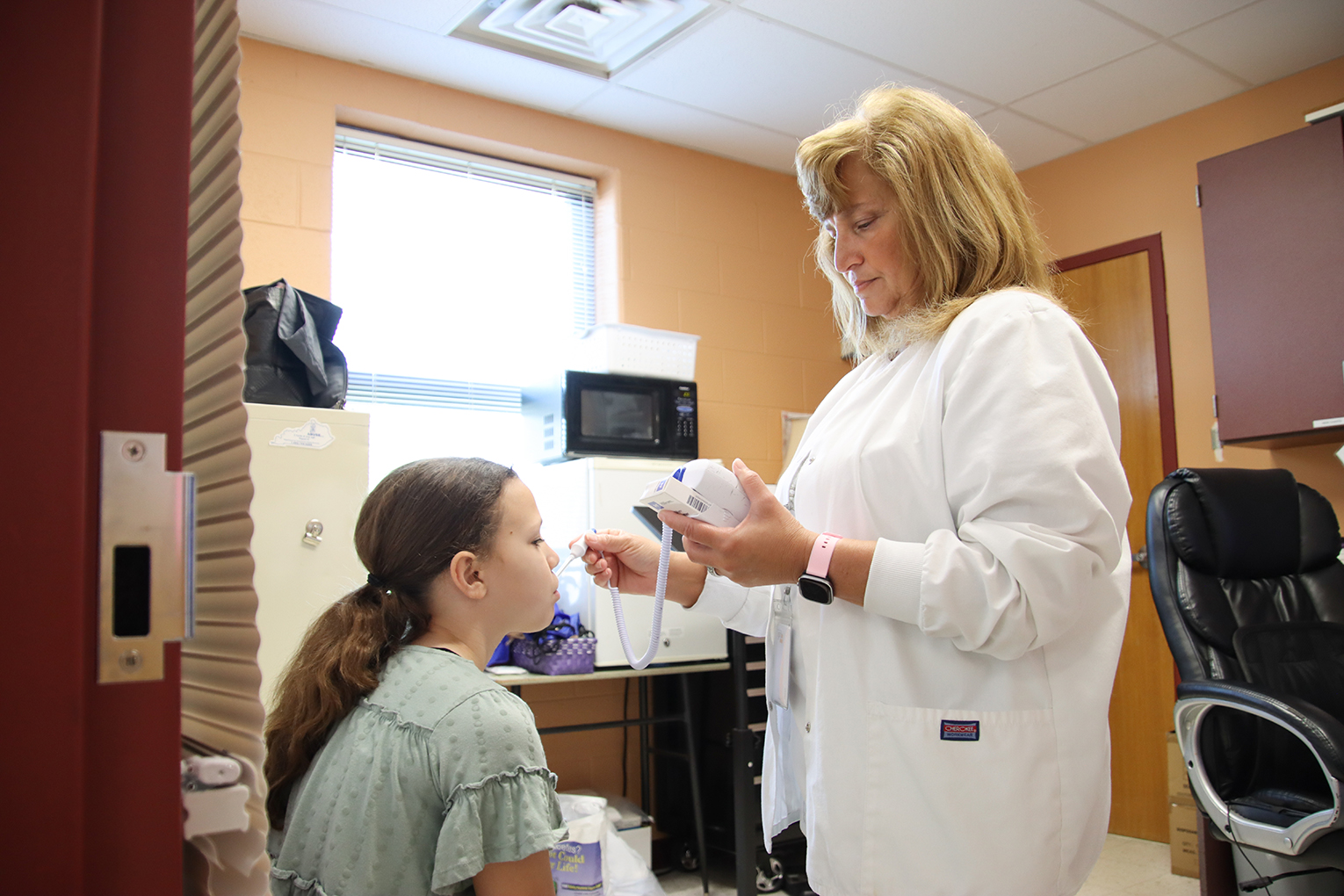
Shauna Traylor, from left, physical education teacher at Murray Elementary School, and 2nd-grade students Landyn Wiggins and Elias Hastings show off some of the physical education equipment bought with funds from its the school’s partnership with the Baptist Health School Wellness Initiative. The school is one of 45 Kentucky schools recognized as award winners in the 2020 Healthy Schools Program, in part due to the support of the initiative.
Photo submitted
- The Delta Rural Network Center encourages wellness programs for students and staff at all 131 public schools in its service area.
- Kentucky is fifth in the nation for Healthy Schools award winners this year.
By Jim Gaines
jim.gaines@education.ky.gov
Judged by population, Kentucky ought to have eight schools on the list of award winners in the 2020 Healthy Schools Program. Instead, it has 45.
This disproportionate success is due primarily to the Baptist Health School Wellness Initiative, offered by the Delta Rural Network Center at Baptist Health Madisonville. Forty-one of Kentucky’s 45 Healthy Schools winners are in the Western Kentucky counties served by the Delta Rural Network Center.
The Baptist Health School Wellness Initiative serves 17 rural Mississippi Delta counties in Western Kentucky. Census tracts in Trigg, Christian and McLean counties also qualify. All 131 public schools in the region participate.
The initiative helps schools establish wellness leadership groups and review wellness policies; offer 20 minutes of daily physical activity beyond the required physical education; and provide professional development for staff and healthy activities for everyone.
The nonprofit Alliance for a Healthier Generation, founded by the American Heart Association and the Clinton Foundation, sponsors the Healthy Schools Program annual awards. The Alliance for a Healthier Generation works with schools, community organizations, healthcare professionals and families to reduce childhood obesity and encourage lifelong healthy habits.
This year there were 521 Healthy Schools winners, at the bronze, silver and gold levels. Kentucky schools received 40 bronze and five silver awards. The silver awards went to West Louisville Elementary School (Jefferson County), SCAPA Bluegrass Middle School (Fayette County), Fulton County Elementary School, Fulton County Middle School and Murray Elementary School (Murray Independent).
Participation is free and not required of schools, but active participation comes with incentives of $500 to $1,500 per school.
At first, the center just incentivized schools to do wellness assessments, said Kelcey Rutledge, Delta Rural Network Center project director. This year, the financial incentive increased if a school applied for recognition, he said.
In the future, schools will be required to meet application requirements and apply for recognition every year in order to receive the incentive, Rutledge said.
About the Program
The Delta Rural Network Center is in the Dr. Loman C. Trover Medical Education and Research Center at Baptist Health Madisonville. It is funded with part of a $900,000 grant from the Federal Office of Rural Health Policy, a division of the Health Resources and Services Administration of the U.S. Department of Health and Human Services.
Beginning in 2001 as the Delta Rural Network Project, it helped set up local community health councils throughout Western Kentucky’s Delta counties. In 2004, it took on a regional approach to focus on obesity and wellness, health literacy and oral health.
Rutledge and Baptist Health also have worked as an intermediary partner of the Alliance for a Healthier Generation’s Healthy Schools Program since November 2013.
Baptist Health is the largest healthcare provider in Kentucky. Rutledge, who has worked with the Baptist Health School Wellness Initiative for 17 years, said the choice was made to focus the initiative’s anti-obesity efforts on schools, figuring that was the best way to reach the most people.
The center’s initial target was to get 25 schools on board – one per county the center serves, plus pilot programs in five more schools, he said.
The center has offered the program since 2005, Rutledge said.
The first Kentucky school recognized was Livingston County Middle School, in the 2013-2014 school year. Fifteen of the region’s schools were recognized in the 2018-2019 school year.
This year, Kentucky ranked fifth in the nation for the most Healthy Schools Program awards, just surpassing California, according to Jim Tackett, director of the Coordinated School Health Project, Division of Support Services, in the Kentucky Department of Education’s (KDE’s) Office of Finance and Operations.
“Real change occurs when the instruction, programs, professional development and policy work in tandem,” he said. “This intentional focus of school staff and community partners is generating great success.”
Details of Participation
The Delta Rural Network Center assigns five counties to each of four project specialists, who help school administrators organize wellness committees. The committees use the Alliance’s online assessment to set goals aligned with their school wellness policies.
Project specialists visit each school at least once a month to work with committee coordinators on concrete wellness promotion plans.
Schools have to form sustainable wellness groups that meet four times a year, retain physical activity programming beyond the required health and physical education, make use of the Healthy Schools Program online assessment tool and update their action plans by Oct. 1 each year.
The assessment covers six topics:
- Wellness policy
- Nutrition standards
- Health and physical education
- Smart snacks, as defined by U.S. Department of Agriculture
- Additional physical activity
- Employee wellness efforts
Participation in the Healthy School Program satisfies KDE’s wellness requirement, so schools essentially get double credit for it, Rutledge said.
“This is an example of how we should address the health and academic needs of the whole child,” Tackett said. “Movement is essential for students throughout the day in order to maximize learning and comprehension while lessening time-off task and disciplinary issues. Likewise, nutritious meals address food insecurities, growth and development and family challenges.”
One School’s Experience
Since beginning its participation, Murray Elementary School is offering more wellness programs for staff, and encouraging all personnel to think about stress management and healthy eating, Principal Denise Whitaker said.
“We want them to take care of themselves, and make sure they’re not forgetting to take care of themselves, because that’s important,” Whitaker said.
Getting groups of school staff to exercise together – or just publicly discuss it – also creates great role models for students, she said.
Personnel from the center attend the school’s quarterly wellness committee meetings and offer plenty of suggestions, she said.
Teachers, counselors, administrators, the district nurse and psychologist, cafeteria manager and parents gather to discuss policy at start of year, and brainstorm ideas to improve student and staff wellness.
Because of the school’s work with Baptist Health, the committee is sure to address all six subject areas, Whitaker said.
Per Baptist Health’s recommendation, Murray Elementary lengthened its school day by 5 minutes to give students a 20-minute recess instead of 15, Whitaker said.
“Students love it,” she said.
Another recommendation was to ensure health instruction doesn’t take too much time away from physical activity, so classroom teachers are shouldering more of that teaching, Whitaker said.
“Definitely Baptist Health has made us look at different ideas, different ways to approach things,” she said.




Leave A Comment